Sci-Tech
Realme Narzo 70 Pro 5G Review: Best Camera Phone Under Rs. 20,000?

When Realme first launched the Narzo series in 2020, its primary target was budget-conscious online consumers wanting the best value for their money. Fast-forward to 2024, and the company has recently unveiled the latest iteration, the Realme Narzo 70 Pro 5G. While the device uses the same processor as its predecessor, has Realme once again claimed the title of the sub-20K king of 2024, or have iQOO and Lava seized the throne? Let’s find out with the Realme Narzo 70 Pro 5G review.
Realme Narzo 70 Pro 5G Review
Summary
The Realme Narzo 70 Pro 5G stands out in its price segment by prioritizing design while also boasting one of the best main cameras.
Realme Narzo 70 Pro 5G Review: Design and Hardware
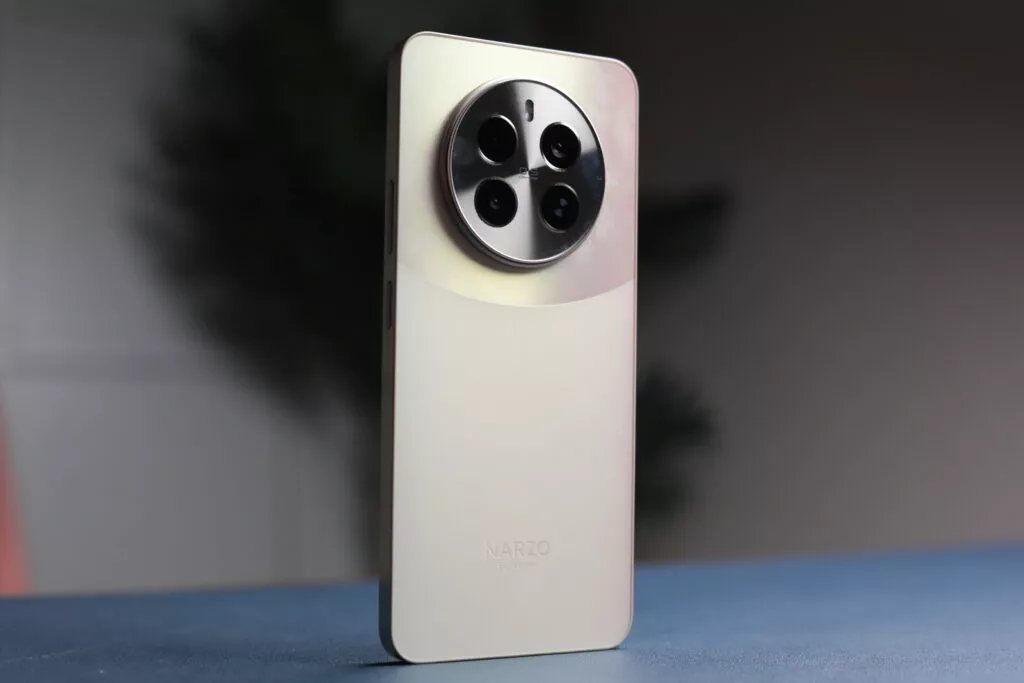
When we first unboxed the Narzo 70 Pro 5G, the back design immediately caught our attention. Instead of opting for a regular back panel, Realme put a lot of thought and effort into making it unique. While this design may not appeal to everyone, especially in the golden color variant, the green option looks neat and aesthetic. However, it is important to note that the dual-tone back panel and matte surface make the Narzo 70 Pro 5G quite slippery.
Moving on to how it feels in hand, the first thing that would strike anyone is the presence of plastic flat sides. While these edges give the phone a premium appearance, they also make it difficult to hold for extended periods. Moreover, the shiny nature of these edges makes them prone to scratches and scuffs.
Furthermore, the camera module might lead one to assume the phone features a quadruple-camera setup due to the four holes. However, this is not the case; the Narzo 70 Pro 5G only sports a triple camera setup, with the fourth cutout present for symmetrical purposes.
Realme Narzo 70 Pro 5G Review: Display
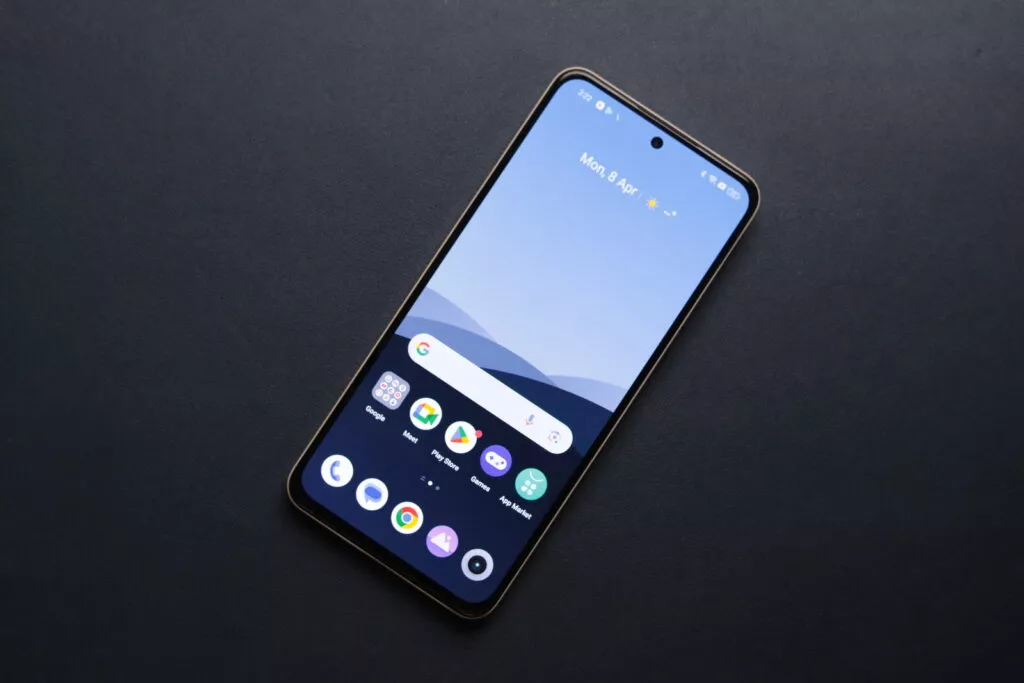
The Narzo 70 Pro 5G houses a 6.67-inch FHD+ 120Hz AMOLED HDR10+ display with a local peak brightness of 2000 nits. Specs aside, the panel’s quality is impressive, delivering vibrant colors, excellent outdoor visibility, and deep blacks. Moreover, with Widewine L1 certification and a 3.5mm headphone jack included, the Narzo 70 Pro offers a stellar content-watching experience.
Refresh rate
The Narzo 70 Pro offers three refresh rate settings: High, Standard, and Auto-select. While one might assume that the auto-select setting would provide the best balance of smoothness and battery life, this is not the case. The setting limits the refresh rate to only 60Hz in many third-party apps, including Realme’s apps like the Gallery. Moreover, even the high setting only increases the refresh rate in certain apps, making using the Narzo 70 Pro a somewhat weird experience.
However, since the refresh rate settings work as expected on other Realme phones, we believe the issue could be a software bug. As a result, we have reported the problem to the Realme team, who are currently investigating it.
Fingerprint sensor and durability
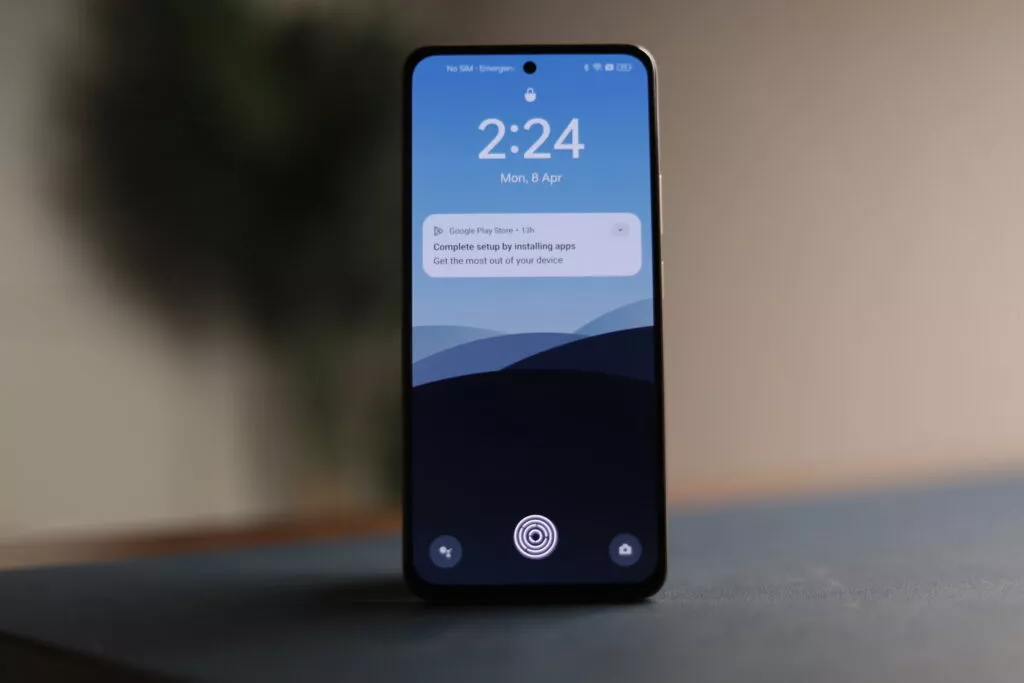
The front also houses an optical fingerprint sensor, which performed well in our testing, unlocking the phone reliably even with wet fingers. Additionally, regarding durability, the Dragontrail Star 2-protected screen remained scratch-free. Moreover, Realme also includes a pre-applied screen protector.
Realme Narzo 70 Pro 5G Review: Performance and Battery

Similar to many phones in its segment, the Narzo 70 Pro features the MediaTek Dimensity 7050 chip, with two Cortex-A78 cores running at 2.6 GHz and six Cortex-A55 cores running at 2.0 GHz, along with the ARM Mali-G68 GPU. Additionally, the device comes with up to 12GB of RAM and 256GB of internal storage. Our 8+128GB variant performed great during our two weeks of testing, showcasing fast loading times, quick opening and closing animations, and no stutters.
Moving on to synthetic benchmarks, the Narzo 70 Pro 5G scored 956 in Geekbench’s single-core test and 2426 in the multi-core test, positioning it on par with other devices featuring the same chipset. Additionally, in a 30-minute 30-thread throttle test, the device managed to sustain 90% of its maximum performance. Moreover, in 3DMark’s Wild Life test and the Antutu Benchmark, the device scored 2265 and 608769, respectively.

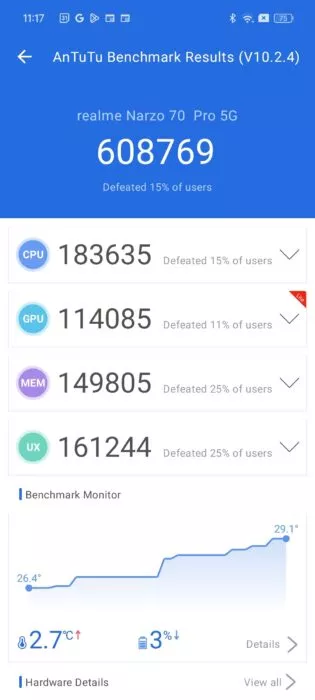
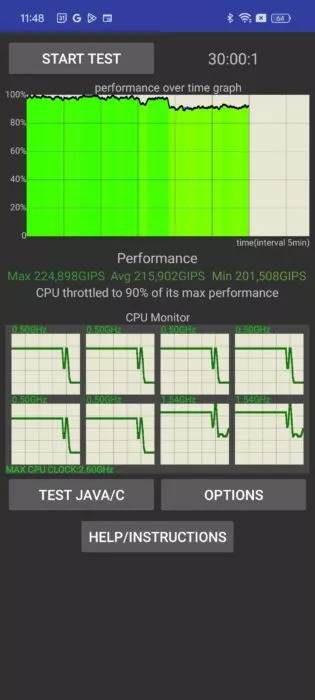
Finally, the overall experience was positive regarding gaming, with no lags or issues affecting gameplay. Additionally, the phone can handle games such as CODM, CODM Warzone, and BGMI in medium settings. Nevertheless, it is important to note that the device does warm up during gaming, but nothing excessive.

Battery Life
With a massive 5,000mAh cell, battery life isn’t a problem for the Narzo 70 Pro. The phone easily lasted a full day of heavy usage, including taking photos, playing games, and watching YouTube videos. Moreover, with the included 67W fast charger, you can recharge the phone in under an hour.
Realme Narzo 70 Pro 5G Review: Cameras
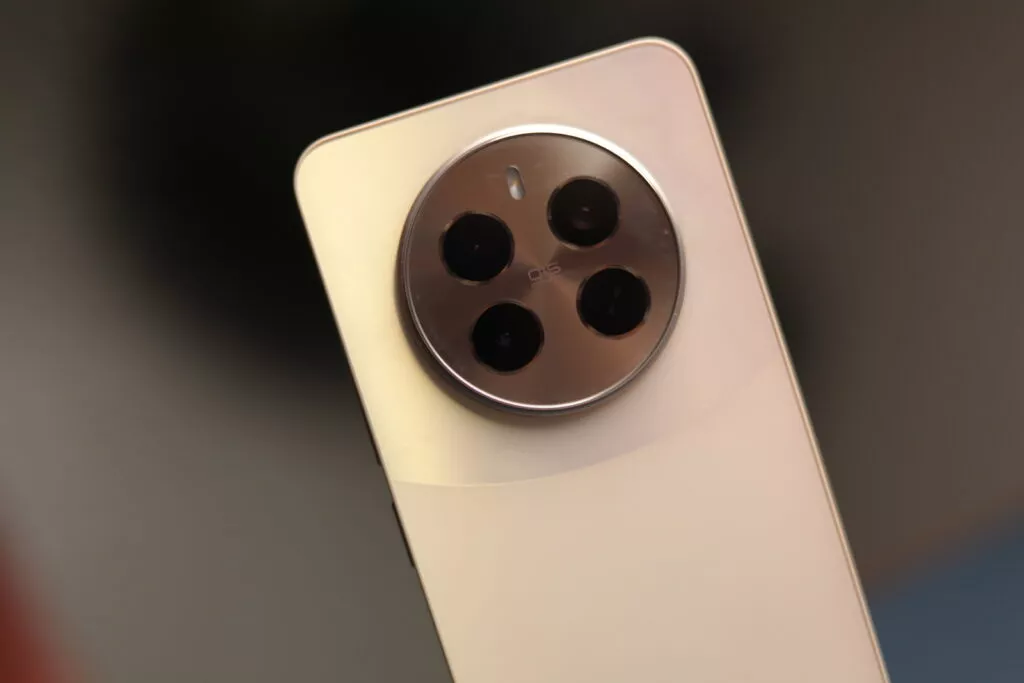
When Realme announced the Narzo 70 Pro 5G, it made bold claims about the camera performance, partly due to the new 50MP Sony IMX890 main camera sensor. And we can confirm that many of these claims hold true. However, before delving into details, it’s worth noting that the Narzo 70 Pro also features an 8MP UltraWide camera.
Starting with the main camera, the photos surprised us with their great detail, vibrancy, and HDR capability. The fast shutter time added to the ease of capturing photos. However, the device’s biggest strength lies in its skin tone rendering. Compared to phones like the Lava Blaze Curve 5G, the Narzo 70 Pro’s skin tones were aesthetically pleasing and more true to life. While some photos appeared slightly oversaturated, the main camera excelled in daylight conditions.






As the phone lacks a dedicated telephoto sensor, the main camera also serves as the portrait lens, and the results are impressive. Realme’s edge detection and image processing have improved, evident in the sharpness and accuracy of portraits, even in indoor lighting conditions.



While the Narzo 70 Pro 5G cameras generally perform well, the 2x zoom capabilities when capturing human subjects seemed somewhat bizarre. This is because the device tended to blow out highlights, resulting in pale-looking photos.

Nighttime photos
Considering the device performed great in daytime conditions, our expectations were high for nighttime photos as well. While the device captured some decent photos, the results lacked details in very low-light scenarios, and noise crept in. Nevertheless, such performance is expected for phones in this price range and shouldn’t be a deterring factor for any potential buyer.

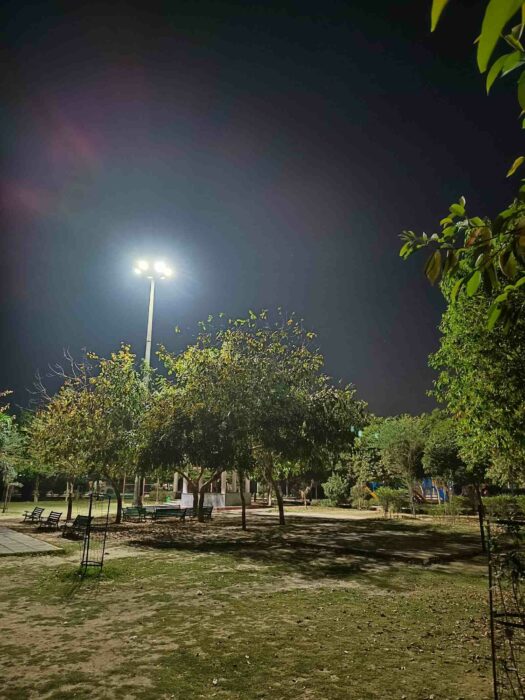

UltraWide photos and Selfies
Similar to other phones, the UltraWide camera is hit-or-miss in every condition. During the day, it captures good photos with ample details and HDR. However, in low-light or indoor conditions, the quality deteriorates significantly, with noise becoming noticeable.

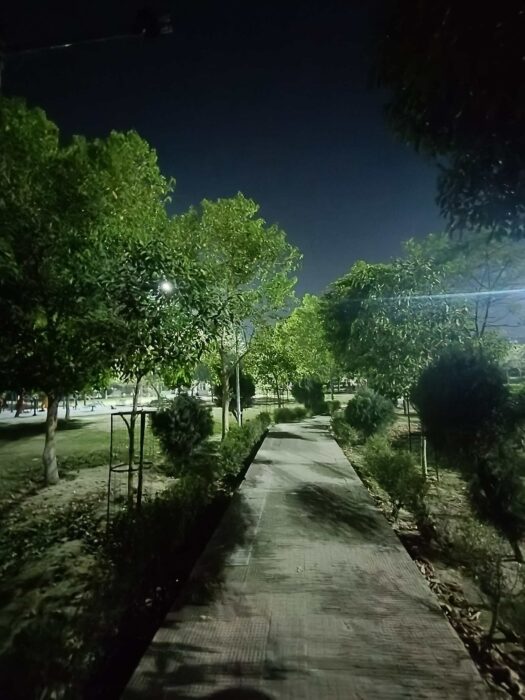

Fortunately, the 16MP selfie shooter performed pretty well in our testing, capturing ample details and vibrance, at least in daylight. However, in low-light conditions, the photos came out muddy due to a lack of detail.


Videos
With the help of OIS, the 4K@30fps videos from the Narzo 70 Pro 5G were stable with good dynamic range and sharpness. While we did observe some noise during the night, it was nothing out of the ordinary. Moreover, it is important to note that you can only record 1080p videos from the UltraWide and selfie cameras.
Realme Narzo 70 Pro 5G Review: Software and Speakers

When Realme launched the Narzo 70 Pro, they promised that they had significantly reduced the bloatware, and that’s a statement we can confirm. The phone, running on Android 14 with Realme UI 5.0 on top, comes with significantly fewer pre-installed apps, which enhances the user experience and gives it a more premium feel. Additionally, while there aren’t any “hot apps/hot games” folders, the search function does contain ads and trending app recommendations, which isn’t ideal. Moreover, Realme’s update policy is still limited to 2 years of software updates and three years of security patches.
Moving forward, the biggest talking point at the event was the Air Gestures. In our testing, they performed better than expected. If you find these air gestures to be a cool party trick, then they work great, especially since you can navigate the entire device with them. Moreover, with platforms like Instagram and TikTok popularizing short video content, you can also scroll through reels and TikToks with gestures without using your hands. Finally, regarding the speakers, the stereo setup proved ample for watching movies or playing songs.
Is the Realme Narzo 70 Pro 5G worth it?

At a starting price of Rs 19,999, the Narzo 70 Pro competes head-to-head with the Lava Blaze Curve 5G and the Vivo T3 5G. While it’s safe to say that the Blaze Curve has the better software experience, and the T3 boasts better performance, the Narzo 70 Pro is for people who value a great main camera, along with a unique design that is sure to turn heads.
Sci-Tech
As the E.V. Revolution Slows, Ferrari Enters the Race

Gliding on robotic haulers, a line of Ferrari frames maneuvers through a gleaming new factory in Northern Italy. At each station, engineers in cherry red uniforms add a component — an engine block, a dashboard, a steering wheel — as they transform the bodies into hybrid vehicles. Up next: fully electric.
A lot is riding on Ferrari’s 200-million-euro “e-building,” which went into operation last month and is nearly twice the size of Rome’s Colosseum. The factory is intended to bring the 77-year-old sports-car maker, known for the sonorous vroom of its gas engines, into the age of electrification.
But the effort comes at a precarious time for the auto industry. The transition to electric vehicles, which was supposed to quickly usher in an era of climate-friendly transport, has instead been squeezed by costly investments and slowing global demand.
Other luxury carmakers have struggled to go electric. Mercedes-Benz and Lamborghini have reduced their ambitions. Tesla reported declining second-quarter sales on Tuesday, and Ford Motor said in April that it would shift production to more hybrids as E.V. losses piled up. A growing trade war between China and the West also threatens to stifle growth.
Despite the challenges, Ferrari sees an opportunity in the industry’s inevitable march toward electrification to reach a new consumer: the wealthy environmentalist. It intends to unveil its first fully electric model in the fourth quarter of next year. As part of its strategy, the carmaker has enlisted LoveFrom — the agency founded by Jony Ive, Apple’s former design chief, and the industrial designer Marc Newson — to hone the car’s appearance.
There is plenty of mystery shrouding the yet-to-be-named car, including its battery life and what it will sound like. The company has not disclosed its look, production run or price tag. But it could be one of the most expensive electric vehicles on the market, analyst say, surpassing Porsche’s $286,000 Taycan Turbo GT.
Ferrari’s foray into electric will be notable for other reasons. Regulators may be pushing electric vehicles, but there is lingering skepticism in the marketplace. Winning over fans of combustion engines will not be easy — even for Ferrari. And the industry is desperate for an automaker, any automaker, to prove that electric vehicles can drive big profits.
“It’s worth watching whether a Ferrari E.V. can maintain the kind of price premium you’d associate with a Ferrari,” said Martino de Ambroggi, an automotive analyst at Equita, an investment bank in Milan. “Often, a Ferrari purchase is also viewed as a kind of investment. Only after a few years will we see if that investment in an electric Ferrari holds up.”
Benedetto Vigna, Ferrari’s chief executive, is doing his best to keep the market in anticipation. In an interview last month in the new plant, he said the company would commence full-scale electric vehicle production by early 2026. By 2030, electric and hybrid cars will make up as much as 80 percent of Ferrari’s annual output as the company seeks to meet stringent European Union emissions mandates.
In the meantime, the e-building will roll out two models: the SF90 Stradale, a plug-in hybrid, and the combustion engine Purosangue.
Ferrari does not need an electric vehicle to pad its bottom line. Under Mr. Vigna, a former executive at the chip maker STMicroelectronics who took the helm nearly three years ago, the company has been on a tear. The stock is one of the best performers in Europe this year, giving it a roughly $75 billion market valuation, higher than that of Ford or General Motors. Profits are soaring alongside prices at Ferrari, which makes some of the most expensive cars on the planet. There’s a three-year waiting list for some models.
Ferrari’s success over the years on the Formula 1 track has also led to a lucrative corporate sponsorship and merchandise business that has transformed it into a luxury brand with a sporty flair. Ferrari’s prancing horse logo can be found on high-end apparel like a €790 cashmere sweater.
Mr. Vigna sees the electric vehicle as part of the company’s growth strategy, despite the industry’s slowdown. “There are some potential clients, I have them clearly in mind, who will never become part of the family unless there is an electric car,” he said.
But challenges loom. Enthusiasts who had gathered outside the factory gates last month wondered: Will it look, handle and sound like the classic Ferrari growler, or have the understated whine of most electric vehicles?
“When you think of a Ferrari, it still has that kind of engine sensation, and you also think of the roar,” Mr. de Ambroggi said. “I don’t know how Ferrari resolves this.”
Mr. Vigna fields that question often, especially from longtime customers, or Ferraristi. They seem to be channeling the deceased founder, Enzo Ferrari, who once broke down in the simplest terms how he built some of the fastest cars on the planet: “I build motors and attach them to wheels.”
Mr. Vigna’s E.V. pitch has a different ring. “The electric engine will not be silent,” he said. “There are ways to make sure that the emotion comes through from driving an electric Ferrari that is the same as when you drive a hybrid or when you drive a thermal Ferrari.”
Battery life is another puzzle piece. Because Ferraris often sell for a higher price on the secondary market, the concern about battery degradation, and its impact on the long-term value of the car, may be felt more acutely by the Ferraristi.
“The E.V. transition raises a whole lot of new issues for them in terms of how you maintain the vehicle,” said Stephen Reitman, an auto analyst at Bernstein.
Ferrari’s longtime partner, SK On, a South Korean battery maker, will supply the components for the E.V. batteries, which Ferrari will assemble in the e-building, where it will also make the car’s electric motors and axles.
And then there is the matter of price. Last month, Reuters reported that the car would cost at least €500,000 ($540,000). Mr. Vigna pushed back on the speculation, saying it is too early to talk price.
Ferrari still follows its founder’s principle for producing a limited number of extremely expensive cars. Ferrari made fewer than 14,000 last year; even with the e-building, production is not expected to increase much at the start.
The limited numbers may explain why fans make the pilgrimage to Maranello hoping to catch a glimpse of a Ferrari, either on the company’s Formula 1 test track or near its red brick factory.
Knowing demand is high, Mr. Vigna has increased the base price of most models more than 25 percent.
“Ferrari consistently sells less than the market demands, leading to a multiyear order book,” said Mr. Reitman, the Bernstein analyst. With a profit margin of nearly 30 percent, Ferrari’s business more resembles that of a luxury brand like Hermes or Rolex, analysts say.
Mr. Vigna is already thinking about how to market the new electric car. The target customer probably will not be buying the car for purely practical or even planet-saving reasons, he said, adding: “The emotional part of the brain is driving the purchase.”
Sci-Tech
Students Target Teachers in Group TikTok Attack, Shaking Their School

In February, Patrice Motz, a veteran Spanish teacher at Great Valley Middle School in Malvern, Pa., was warned by another teacher that trouble was brewing.
Some eighth graders at her public school had set up fake TikTok accounts impersonating teachers. Ms. Motz, who had never used TikTok, created an account.
She found a fake profile for @patrice.motz, which had posted a real photo of her at the beach with her husband and their young children. “Do you like to touch kids?” a text in Spanish over the family vacation photo asked. “Answer: Sí.”
In the days that followed, some 20 educators — about one quarter of the school’s faculty — discovered they were victims of fake teacher accounts rife with pedophilia innuendo, racist memes, homophobia and made-up sexual hookups among teachers. Hundreds of students soon viewed, followed or commented on the fraudulent accounts.
In the aftermath, the school district briefly suspended several students, teachers said. The principal during one lunch period chastised the eighth-grade class for its behavior.
The biggest fallout has been for teachers like Ms. Motz, who said she felt “kicked in the stomach” that students would so casually savage teachers’ families. The online harassment has left some teachers worried that social media platforms are helping to stunt the growth of empathy in students. Some teachers are now hesitant to call out pupils who act up in class. Others said it had been challenging to keep teaching.
“It was so deflating,” said Ms. Motz, who has taught at the school, in a wealthy Philadelphia suburb, for 14 years. “I can’t believe I still get up and do this every day.”
The Great Valley incident is the first known group TikTok attack of its kind by middle schoolers on their teachers in the United States. It’s a significant escalation in how middle and high school students impersonate, troll and harass educators on social media. Before this year, students largely impersonated one teacher or principal at a time.
The middle schoolers’ attack also reflects broader concerns in schools about how students’ use, and abuse, of popular online tools is intruding on the classroom. Some states and districts have recently restricted or banned student cellphone use in schools, in part to limit peer harassment and cyberbullying on Instagram, Snap, TikTok and other apps.
Now social media has helped normalize anonymous aggressive posts and memes, leading some children to weaponize them against adults.
“We didn’t have to deal with teacher-targeting at this scale before,” said Becky Pringle, president of the National Education Association, the largest U.S. teachers’ union. “It’s not only demoralizing. It could push educators to question, ‘Why would I continue in this profession if students are doing this?’”
In a statement, the Great Valley School District said it had taken steps to address “22 fictitious TikTok accounts” impersonating teachers at the middle school. It described the incident as “a gross misuse of social media that profoundly impacted our staff.”
Last month, two female students at the school publicly posted an “apology” video on a TikTok account using the name of a seventh-grade teacher as a handle. The pair, who did not disclose their names, described the impostor videos as a joke and said teachers had blown the situation out of proportion.
“We never meant for it to get this far, obviously,” one of the students said in the video. “I never wanted to get suspended.”
“Move on. Learn to joke,” the other student said about a teacher. “I am 13 years old,” she added, using an expletive for emphasis, “and you’re like 40 going on 50.”
In an email to The New York Times, one of the students said that the fake teacher accounts were intended as obvious jokes, but that some students had taken the impersonations too far.
A TikTok spokeswoman said the platform’s guidelines prohibit misleading behavior, including accounts that pose as real people without disclosing that they are parodies or fan accounts. TikTok said a U.S.-based security team validated ID information — such as driver’s licenses — in impersonation cases and then deleted the data.
Great Valley Middle School, known locally as a close-knit community, serves about 1,100 students in a modern brick complex surrounded by a sea of bright green sports fields.
The impostor TikToks disrupted the school’s equilibrium, according to interviews with seven Great Valley teachers, four of whom requested anonymity for privacy reasons. Some teachers already used Instagram or Facebook but not TikTok.
The morning after Ms. Motz, the Spanish teacher, discovered her impersonator, the disparaging TikToks were already an open secret among students.
“There was this undercurrent conversation throughout the hallway,” said Shawn Whitelock, a longtime social studies teacher. “I noticed a group of students holding a cellphone up in front of a teacher and saying, ‘TikTok.’”
Students took images from the school’s website, copied family photos that teachers had posted in their classrooms and found others online. They made memes by cropping, cutting and pasting photos, then superimposing text.
The low-tech “cheapfake” images differ from recent incidents in schools where students used artificial intelligence apps to generate real-looking, digitally altered images known as “deepfakes.”
While some of the Great Valley teacher impostor posts seemed jokey and benign — like “Memorize your states, students!” — other posts were sexualized. One fake teacher account posted a collaged photo with the heads of two male teachers pasted onto a man and woman partially naked in bed.
Fake teacher accounts also followed and hit on other fake teachers.
“It very much became a distraction,” Bettina Scibilia, an eighth-grade English teacher who has worked at the school for 19 years, said of the TikToks.
Students also targeted Mr. Whitelock, who was the faculty adviser for the school’s student council for years.
A fake @shawn.whitelock account posted a photo of Mr. Whitelock standing in a church during his wedding, with his wife mostly cropped out. The caption named a member of the school’s student council, implying the teacher had wed him instead. “I’m gonna touch you,” the impostor later commented.
“I spent 27 years building a reputation as a teacher who is dedicated to the profession of teaching,” Mr. Whitelock said in an interview. “An impersonator assassinated my character — and slandered me and my family in the process.”
Mrs. Scibilia said a student had already posted a graphic death threat against her on TikTok earlier in the school year, which she reported to the police. The teacher impersonations increased her concern.
“Many of my students spend hours and hours and hours on TikTok, and I think it’s just desensitized them to the fact that we’re real people,” she said. “They didn’t feel what a violation this was to create these accounts and impersonate us and mock our children and mock what we love.”
A few days after learning of the videos, Edward Souders, the principal of Great Valley Middle School, emailed the parents of eighth graders, describing the impostor accounts as portraying “our teachers in a disrespectful manner.”
The school also held an eighth-grade assembly on responsible technology use.
But the school district said it had limited options to respond. Courts generally protect students’ rights to off-campus free speech, including parodying or disparaging educators online — unless the students’ posts threaten others or disrupt school.
“While we wish we could do more to hold students accountable, we are legally limited in what action we can take when students communicate off campus during nonschool hours on personal devices,” Daniel Goffredo, the district’s superintendent, said in a statement.
The district said it couldn’t comment on any disciplinary actions, to protect student privacy.
In mid-March, Nikki Salvatico, president of the Great Valley Education Association, a teachers’ union, warned the school board that the TikToks were disrupting the school’s “safe educational environment.”
“We need the message that this type of behavior is unacceptable,” Ms. Salvatico said at a school board meeting on March 18.
The next day, Dr. Souders sent another email to parents. Some posts contained “offensive content,” he wrote, adding: “I am optimistic that by addressing it together, we can prevent it from happening again.”
While a few accounts disappeared — including those using the names of Ms. Motz, Mr. Whitelock and Mrs. Scibilia — others popped up. In May, a second TikTok account impersonating Mrs. Scibilia posted several new videos mocking her.
She and other Great Valley educators said they had reported the impostor accounts to TikTok, but had not heard back. But several teachers, who felt the videos had violated their privacy, said they did not provide TikTok with a personal ID to verify their identities.
On Wednesday, TikTok removed the account impersonating Mrs. Scibilia and three other fake Great Valley teacher accounts flagged by a reporter.
Mrs. Scibilia and other teachers are still processing the incident. Some teachers have stopped posing for and posting photographs, lest students misuse the images. Experts said this type of abuse could harm teachers’ mental health and reputations.
“That would be traumatizing to anyone,” said Susan D. McMahon, a psychology professor at DePaul University in Chicago and chair of the American Psychological Association’s Task Force on Violence Against Educators. She added that verbal student aggression against teachers was increasing.
Now teachers like Mrs. Scibilia and Ms. Motz are pushing schools to educate students on how to use tech responsibly — and bolster policies to better protect teachers.
In the Great Valley students’ “apology” on TikTok last month, the two girls said they planned to post new videos. This time, they said, they would make the posts private so teachers couldn’t find them.
“We’re back, and we’ll be posting again,” one said. “And we are going to private all the videos at the beginning of next school year,” she added, “’cause then they can’t do anything.”
On Friday, after a Times reporter asked the school district to notify parents about this article, the students deleted the “apology” video and removed the teacher’s handle from their account. They also added a disclaimer: “Guys, we’re not acting as our teachers anymore that’s in the past !!”
Sci-Tech
Mark Zuckerberg’s Viral Surf Video

As Fourth of July celebrations commenced across the nation, Mark Zuckerberg dropped a video onto his Instagram account that immediately generated hundreds of thousands of views. Indeed, the clip seemed designed for warp speed virality.
Behind a fast-moving boat, Mr. Zuckerberg wakeboards while wearing a tuxedo and sunglasses as he sips from a tall boy. The clip is set to Bruce Springsteen’s 1984 anthem “Born in the U.S.A.” For its half-minute duration, Meta’s multibillionaire chief executive shows off his surf technique.
“Amazing!” commented Lauren Sánchez, the fiancée of Jeff Bezos.
A gaming influencer, @StoneMountain64, wrote, “Now that’s content.”
Mr. Zuckerberg replied, “Just doing my part.”
To Zuck-ologists, the clip was yet another example of the 40-year-old executive’s attempt to remake his image. In recent years, he has gone from a flip-flop-and-hoodie-wearing tech entrepreneur to a sleeker, Richard Bransonesque figure, one who wears Brunello Cucinelli T-shirts, a silver chain and has immersed himself in mixed martial arts.
As one commenter on X put it, “The PR team rehabbing Zuck continues their undefeated streak.”
The video was a sequel of sorts to a video Mr. Zuckerberg posted on July 4, 2021. That one showed him aboard a moving hydrofoil while carrying an American flag to the soundtrack of John Denver’s 1971 hit “Take Me Home, Country Roads.”
The next year he posted a picture of himself wearing an American flag cowboy hat as he grilled sausages. “Smoking these meats,” he wrote in a caption. “Happy 4th!” Last year’s post featured a candid shot of Mr. Zuckerberg and his family.
If social media experts help Mr. Zuckerberg craft his posts, then not much is known about them. Meta representatives have suggested that he does not depend on image consultants. A representative for Meta did not immediately respond to a request to comment.
If the intent behind Mr. Zuckerberg’s patriotic content drops has been to render him more relatable to the American public, despite his approximately $181 billion net worth, according to Bloomberg, they appear to have helped. The online response to this year’s Fourth of July post was largely upbeat, markedly different from the satirical memes that roasted his 2021 hydrofoil post.
But some online observers pointed out an off-note in the clip: its use of “Born in the U.S.A.” Often misinterpreted as a rah-rah anthem, the song tells the story of a Vietnam War veteran who returns home to a lonely welcome and dire circumstances.
Dana White, the chief executive of the Ultimate Fighting Championship, who has long tried to set up a cage match between Mr. Zuckerberg and his tech rival Elon Musk, reacted to the video with a positive comment: “’MERICA!!!!!”
Mr. Musk had a different take, writing on X: “May he continue to have fun on his yachts. I prefer to work.”
-

 African History5 years ago
African History5 years agoA Closer Look: Afro-Mexicans 🇲🇽
-

 African History5 months ago
African History5 months agoBlack History Facts I had to Learn on My Own pt.6 📜
-

 African History5 years ago
African History5 years agoA Closer Look: Afro-Mexicans 🇲🇽
-

 African History1 year ago
African History1 year agoMajor African Tribes taken away during the Atlantic Slave Trade🌍 #slavetrade #africanamericanhistory
-

 African History1 year ago
African History1 year agoCameroon 🇨🇲 World Cup History (1962-2022) #football #realmadrid #shorts
-

 African History5 months ago
African History5 months agoBlack History Inventors: Mary Kenner 🩸
-

 African History1 year ago
African History1 year agoPROOF AFRICAN AMERICANS AIN'T FROM AFRICA DOCUMENTED EVIDENCE
-

 African History1 year ago
African History1 year agoNo African pre-Columbus DNA? 🤯🤯 #history #mesoamerica #mexico #african
























